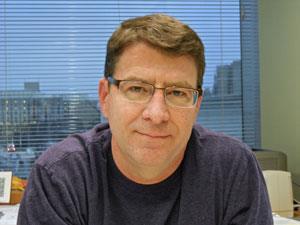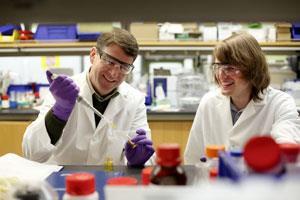
It’s quite easy to see applications for your work on bioadhesives, especially your experiments using a mussel-inspired sealant to repair fetal membranes, but that’s very different to the more straightforward polymer chemistry that you learn at school.
Well we do both. My lab is interested in understanding these natural biological adhesives and then creating synthetic mimics once you know something about the biological system. In theory, to do the second thing, you should be able to understand everything you can about the biological material and then you can go from there. But the reality is that if we were going to wait for that to happen – to have a full understanding of the biological tissue – we’d never get there because they’re very complex.
I’ve been working on marine adhesives and materials for 15 years and we still don’t understand more than 20% of the things we should about the biological tissue. So we do both in parallel and as we learn more about the biological systems it informs how we go about designing and processing the synthetic materials.
So what do we understand about these marine materials?
The starting point for our work came from the work of other groups, particularly Herbert Waite at the University of California, Santa Barbara. They are essentially protein glues, and one of the major discoveries that Waite made was that they have an unusual amino acid composition. They are highly polyphenolic proteins and the compound DOPA, which is found in these proteins, is not generally found in high concentrations in proteins in mammals or invertebrates. So that was the focus of a lot of attention and still is today – understanding the role of the amino acids in those proteins and developing synthetic polymer systems which incorporate DOPA or the catechols that the DOPA side chain is based on.
But as the field has progressed there have been other discoveries that are interesting as well, for example the role of transition metals in mussel byssal tissue, which is the adhesive structure that is highly enriched with transition metals. So there’s another dimension. We want to understand the role of the transition metals in the biological system but also develop synthetic polymer mimics. The chemistry with the transition metals is very complicated and the nature of the chemical interactions that can occur are highly pH dependent because there are interactions that range from covalent crosslinking of proteins to coordination reactions. So we’ve been looking at the mechanical role of transition metals like, iron(III), in these coordination interactions and it’s becoming clear from not just our work but other peoples’ that non-covalent interactions with the transition metals are important contributors to the mechanical properties of the byssus. Of course you can then translate that into the synthetic polymers and actually it’s an interesting point to make that if the architecture of these synthetic systems is well defined you can actually use these well-defined polymers to ask some fundamental questions that are more challenging if you are working with a complex protein.
So you adjust the synthetic model so you can see what’s happening?
Yes, for example we can build molecules with a very precise branched architecture – precise in terms of the length of each arm – with a functional group at the end. Because of the defined architecture we can do very detailed experiments using these synthetic molecules to understand, for example, the pH dependence of iron-catechol interactions and the mechanical implications of these interactions.
These are experiments you simply can’t do with the native proteins because the native proteins are very complex and you can’t exclude the contributions from other amino acid residues. So we like to say we try to understand the biological system and then design these polymers for applications but actually the polymer work is sometimes very important in helping us to understand the biological system, even though they’re very primitive mimics of the proteins.
Do you see yourself as applications focussed or poking stuff to understand it?
We do both and we like to think of ourselves as doing both – one foot in each area.

Yes and no. I’m appointed in a biomedical engineering department so some students who are working on these projects have a biomedical engineering background which is not the same as say a chemistry background. Most students, and most post-docs, will fall into one category. The person who does the single molecule mechanics experiments in my lab, for example, is very specialised and he would not be the same person who would undertake something on the applied side.
What are the main applications for your synthetic polymers, are they just biomedical?
Not exclusively, but the funding sources right now are primarily in health related areas. We have a lot of funding from the National Institutes of Health in the US and obviously their main interest at the end of the day is to contribute to basic understanding as well as the applications of new materials, new devices and new therapies. So we work through the government funding as well as some corporate and institutional funding towards applications. The application you mentioned before, fetal surgery, has been a great passion for me over the last few years. I only really became involved in this three–four years ago but it’s become really important to me.
It’s the kind of medical problem that has too small a market to interest big companies and so the surgeons work in this area and do wonderful things without having all the tools they would like. One example of a tool they need is for sealing ruptures in the fetal membrane that occur spontaneously or after an interventional procedure. The ruptures can lead to leakage of amniotic fluid and when that happens you have two major problems. First, is the risk of infection and second is the premature induction of labour. Either way you have a very serious medical problem for the mother and the fetus and there aren’t many ways to treat this apart from bed rest.
There’s a small community of fetal surgeons that have trained for many years to try and avoid these ruptures but if it happens there’s not a lot they can do. So we’re developing materials to try and seal the membranes after rupture. Here obviously the tissue is wet and there’s a large volume of high ionic strength fluid. This is not very different from the conditions encountered by mussels- thus providing a great argument for learning how mussels and other marine organisms can accomplish wet adhesion.
How easy is it to make these materials biocompatible?
That’s a great question and something we spend a lot of time thinking about. Biocompatibility is an all-encompassing word: but it’s all about context. All we can say is we try to develop systems based on biocompatible polymers and DOPA and then formulate them in a way that doesn’t induce a severe inflammatory response. But any synthetic material has some level of that response. There’s an interesting give and take between in vitro results and in vivo results. A positive in vitro result won’t necessarily translate to a positive in vivo result. One of the interesting things is that the opposite is also true. Sometimes in vivo cell toxicity assays give a borderline response but in vivo we see really good results. We choose the polymers and how we go about the functionalisation and purification very carefully and then we do in vitro and in vivo tests.
Going back slightly, what made you get into bioadhesion?
The guy I mentioned earlier, Herbert Waite. When I was a young faculty member I used to block off one full day a month and just go to the library and look at all the new journal issues that had come in. And I used to try and make a point of trying to read out of my comfort zone, in areas I really wasn’t trained in. And one of those times I encountered one of his papers which described these proteins, the mussel adhesive proteins. And I said, wow, this is really interesting. Then I started looking for more of his papers and it just struck me, as a materials scientist, as an interesting translation opportunity, which it’s turned out to be. To this day I often tell my students that story because I don’t think they really appreciate how important it is not just to read the literature, but to read the literature outside of what you happen to be looking for that day, that hour.
Do you think the way we download papers has changed over the years?
I’m worried and I’ll tell you why. I think very few of our students these days will read full journal issues. This is how I encountered science, by browsing tables of contents. You can still get them, right? Those table of contents emails. But I’ve noticed my students don’t always subscribe to those, so they end up searching on a specific term and this is where you find very specific papers you’re looking for but you miss the broader view. I’m a little worried about that process becoming obsolete.
So if you were to give any advice it would be to read around the subject?
Yes, and I do give that advice all the time to my group members: read outside of your comfort zone. For example, this practice has recently led us to discover similarities between mussel adhesive proteins and plant polyphenols, prompting us to explore materials inspired by plant polyphenols.







No comments yet